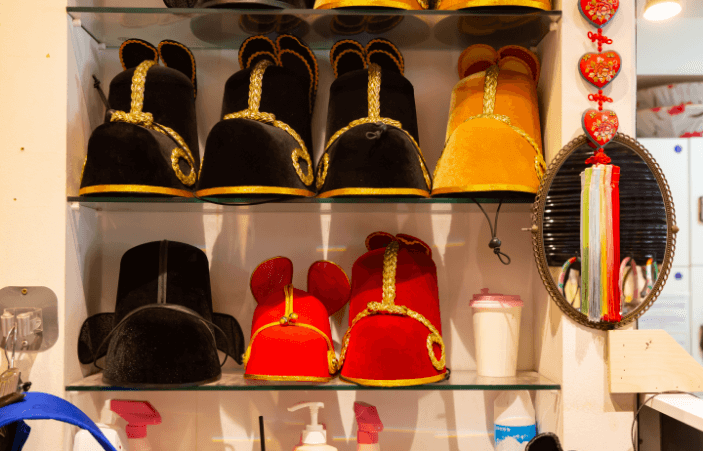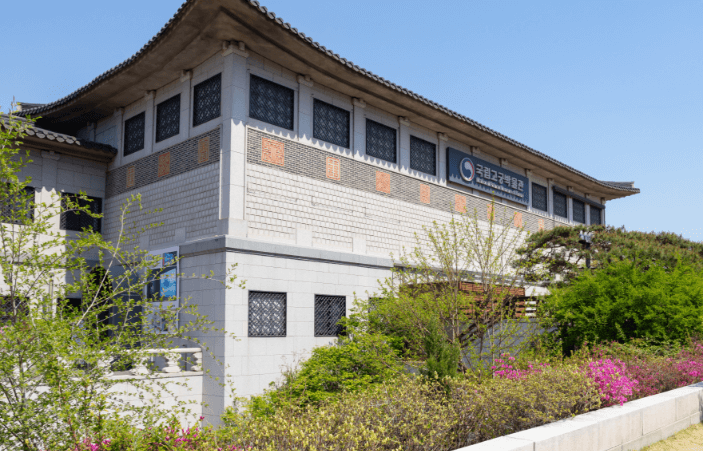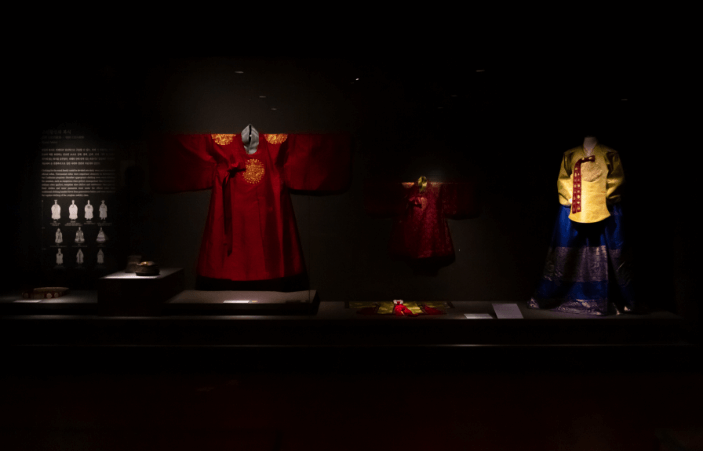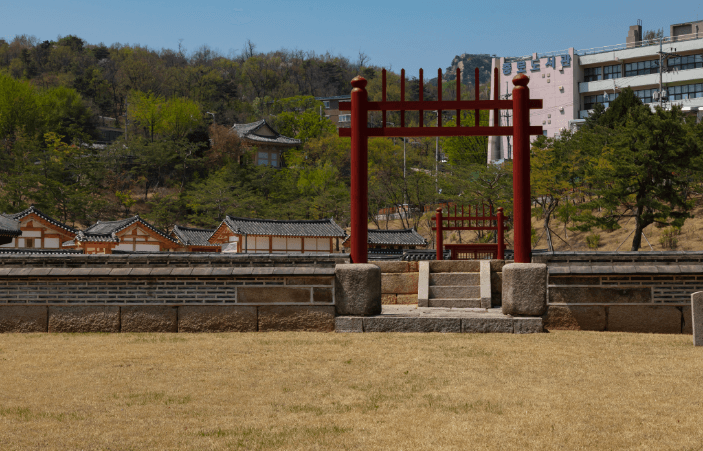Seochon, the area neighboring the “Foremost Royal Palace of the Joseon Dynasty” – Gyeongbokgung – retains much of its historical atmosphere, allowing visitors to journey back in time to the Joseon era. Embrace the role of a Joseon king, wear a dragon robe, savor royal delicacies, and retrace the king's procession from Sajikdan Altar to Hwanghakjeong Archery Field. This travel itinerary remains one of our most popular.
* Walking Standard

A day in the life of a Joseon king began with wearing the appropriate attire. The king wore a variety of garments depending on the situation. The most iconic of these is the Gonryongpo, worn during daily tasks. This round, typically red robe has intricate dragon patterns embroidered with gold thread on the chest, back, and shoulders. Sometimes a blue version was also worn. Paired with an Iksungwan (a hat with horn-like protrusions), Okdae (a belt decorated with jade), and Mokhwa (official leather shoes), this completes the daily outfit of a Joseon king.
In the vicinity of Sajik-ro in front of Exit 4 of Gyeongbokgung Station on Seoul Subway Line 3 there are several shops where you can rent a wide array of Hanbok, including the Gonryongpo. These establishments provide the Gonryongpo, Iksungwan, and Mokhwa and Yungbok worn by the king during hunting excursions. Rentals of the queen's regular attire and corresponding hairstyling are also available.
- Address Sajik-ro area, in front of Exit 4 of Gyeongbokgung Station, Seoul Subway Line 3
Now that you are clad in the Gonryongpo, let's venture toward the palace. Our first destination is Geunjeongjeon, the main hall of Gyeongbokgung. It was a pivotal venue in the palace where important ceremonies were held and where subjects gave their morning salutations, known as Joerye, to the king. Depending on the participants, Joerye was categorized as either Jocham (with many officials) or Sangcham (with a few high-ranking officials). While Jocham was held roughly four times a month in Geunjeongjeon, Sangcham was an almost daily sight in the king's working chamber, Sajeongjeon. During Jocham, officials would line up on the designated stone markers according to their rank and perform the Saberye (a ceremony that involved saluting four times) before the king and await his commands.
Standing on the raised platform of Geunjeongjeon, you can see the lined stone markers, a sight likely familiar to Joseon monarchs. A recommended way to truly appreciate the palace is to view it from the king's perspective, and Geunjeongjeon's platform offers such an experience. Inside Geunjeongjeon, the king's throne can be seen beneath vibrant ceiling paintings. There are occasional special tours of the interior of Geunjeongjeon. Reservations for these can be made on the Gyeongbokgung website.
- Address 161, Sajik-ro, Jongno-gu, Seoul
- Inquiry 02-3700-3900
After completing morning studies known as Jogang, the king ate his morning meal. His meals were prepared in a kitchen called Sojubang near Geunjeongjeon. There were many kitchens in the palace to cater to the vast number of residents, and Sojubang was the largest. Sojubang was subdivided into Naesojubang, which prepared the royal couple's meals, and Waesojubang, which was responsible for palace feasts. Another division, Saenggwabang, managed desserts and unique dishes and was one of the six main palace departments. It was also referred to as "Saengmulbang" or "Saenggeotbang."
The Sojubang, dismantled during Japanese occupation, was restored in 2015. Every year, the “Saenggwabang Experience Program” is held during the first half (April-June) and the second half (September-November) of the year. Visitors can taste palace snacks and medicinal teas that the Joseon kings once enjoyed, based on the Annals of the Joseon Dynasty. These include rice cakes made with nine medicinal ingredients called “Guseonwangdogo,” various palace snacks such as Yakgwa and Hodujeonggwa, and unique palace medicinal teas such as Ganggyedaum, Samgyulda, Gamgukda, Jehocha and more. The specific menu and procedures may vary slightly each season, so ”visitors are advised to check the Korea Cultural Heritage Foundation website for detailed information.
- Address 161 Sajik-ro, Jongno-gu, Seoul
- Inquiry 1522-2295
To properly understand the royal lifestyle, visit the National Palace Museum of Korea in Gyeongbokgung Palace. The museum displays a vast range of artifacts that illustrate the daily lives of royalty, ranging from the king's jade throne to an exclusive royal toilet called Maehwateul. The exhibit spaces from the basement level to the second floor display everything from King Taejo Lee Seong-gye's portrait to memorabilia related to King Sunjong, the last monarch of the Joseon Dynasty.
The main entrance is directly connected to the second floor, and the viewing route leads visitors down to the first floor and then the basement. Due to the museum's straightforward layout, visitors are unlikely to miss any significant exhibits. Pick up a pamphlet from the information desk on the second floor and start the tour with the “Royal Court of Joseon” exhibit. The seven exhibit rooms are filled with high-quality artifacts from Joseon royal culture, so take ample time to explore.
- Address 12 Hyoja-ro, Jongno-gu, Seoul
- Inquiry 02-3701-7500
Joseon kings resided in the main palaces, but they occasionally ventured outside for royal processions. The most notable of these were rituals held at Jongmyo or Sajik. In the Confucian kingdom of Joseon, Jongmyo represented the royal ancestral shrine, and Sajik housed the shrines of land and grain deities. This significance is reflected in the frequent references to “Protect Jongmyo and Sajik!” in historical dramas. Sajikdan Altar is a 20-minute walk from Gyeongbokgung and is the ritual altar for Sajik. Therefore, at the center is an open altar and not a building.
If you pass through the main gate with the vivid inscription “Sajikdan,” you will see a sizeable enclosing wall with red gates. Another enclosure lies within, also with red gates on each side. Considering that even royal tombs typically have only one such gate, the presence of eight gates underscores the sanctity of the site. Perhaps you can imagine the days when kings wearing Gonryongpo, prayed here for the prosperity of the country and its people.
- Address 89 Sajik-ro, Jongno-gu, Seoul
- Inquiry 02-739-7205
Archery was an essential skill for Joseon scholars and a significant martial art of the royal family. Taejo Lee Seong-gye was renowned for his extraordinary archery skills and was capable of precisely hitting distant targets. Subsequent kings excelled in archery and enjoyed watching their ministers participate. Sometimes, they organized a grand archery event called “Daesarye.”
Hwanghakjeong is a pavilion on an archery range established by Emperor Gojong during the Great Han Empire. The name “Hwanghakjeong” originates from the perception that Gojong, wearing a gold Gonryongpo while practicing archery, resembled a golden crane. It was originally located inside Gyeonghuigung Palace, and was moved to its current location due to damage during the Japanese occupation. Although the Japanese shut down archery ranges nationwide, the legacy of traditional Korean archery has fortunately continued at the Hwanghakjeong Archery Range.
- Address San 1-beonji, Sajik-dong, Jongno-gu, Seoul
- Inquiry Hwanghakjeong 02-738-5785, Archery Range 02-722-1600

한국관광공사가 창작한 본 저작물은 공공누리 제4유형 조건에 따라 이용이 가능합니다.
한국관광공사에 의해 창작된 [청와대 코스 ①] 조선 국왕의 행차를 따라서, 서촌 시간 여행은 공공라이선스에 따라 이용할 수 있습니다. 사진 자료의 경우, 피사체에 대한 명예훼손 및 인격권 침해 등 일반 정서에 반하는 용도의 사용 및 기업 CI, BI로의 이용을 금지하며, 상기 지침을 준수하지 않음으로 인해 발생하는 이용자와 제3자간 분쟁에 대해서 한국관광공사는 책임을 지지 않습니다.















